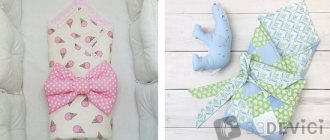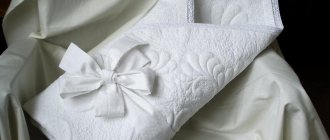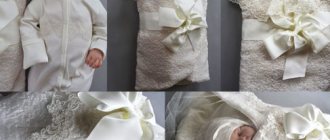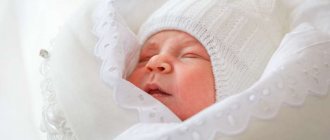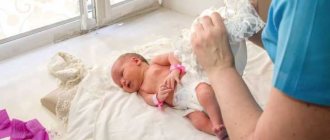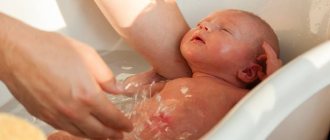The discharge of a baby from the maternity hospital is a very important and at the same time solemn event that will remain in the memory of the parents for the rest of their lives. Therefore, do not forget that in photographs and holiday videos, not only you, but also your newborn baby should look beautiful and elegant.
The baby's first outerwear in life will be an envelope.
It is in it that he will be taken out of the maternity hospital, and for the first time in his life the child will see the sun and the world around him.
Firstly, a beautiful, elegant envelope adds solemnity to the moment and gives a feeling of celebration. Secondly, you can’t do without a warm envelope in the cold season. And in the summer you shouldn’t refuse the envelope, because the baby’s body is not yet adapted to the external environment, his immunity is not yet strong.
Envelopes are used not only for discharge from the parental department, but also at christenings, as well as during walks with baby strollers, as bedding for car seats and sleds.
If you choose a universal transforming envelope, then you can use it as a blanket, as a regular overall, and as a bedding for a child seat or other means of transportation.
Expectant mothers anxiously wait to meet their baby for 9 months, but at the last moment before giving birth, panic and haste may arise. ☝️ To prevent this from happening, you need to collect all the necessary things for the maternity hospital in advance, and most importantly, consider the envelopes for discharge for newborns and choose the appropriate option. It will become the baby’s first “clothes” when meeting the outside world, so the right choice cannot be neglected.
Previously, our mothers and grandmothers independently built something like envelopes or simply made do with blankets and rugs. Today there is no need for this: the variety of assortment in the store is simply amazing. ☝️ However, it can be confusing, because not always the most beautiful and expensive outfit turns out to be practical and successful.
Sizes of envelopes for discharge
Many manufacturers produce envelopes for newborns in several sizes, depending on the weight of the baby. For example, envelopes for a child weighing from 2.8 to 3.3 kg, from 3.3 to 3.5 kg, from 3.5 to 4 kg and for babies weighing from 4 to 6 kg.
Summer envelopes for discharge from the maternity hospital should not be very spacious, otherwise the child will feel uncomfortable in them.
more winter options , with the expectation that the child will have to be carried in an envelope in warm winter clothes and booties. A classic envelope for a child measures 42 by 75 cm, but it is best to focus on the weight and height of your child. For example, according to the results of an ultrasound performed shortly before birth.
DIY transformable blanket for discharge
Many handicraft mothers prefer to sew baby blankets with their own hands. This can be done very quickly. To get started, download a pattern from the Internet or create it yourself. Transfer it to the fabric.
There will be no difficulties, since you will only have to draw a few squares (for the layers of the blanket). Only for the pocket you will need to draw a trapezoid, slightly rounded at the bottom. You will need to run an elastic band along the bottom edge, and if it is square, deformation will occur.
Place the cut pieces right sides on top of each other and sew. After the work is done, turn the blanket out and iron it. Now stitch the product again along the front side. Hook the elastic onto a pin and carefully insert it into the resulting drawstring. The fabric will become slightly gathered. Now place bias tape on the pocket and sew.
Choose fabric for sewing based on the time of year of discharge.
Material for the discharge envelope
When choosing an envelope for checkout, attention must be paid not only to its appearance and functionality, but also to the quality of the material.
☝️ The fabric from which the envelope is sewn must be hypoallergenic, natural and steam-wicking. It should allow steam to pass through well and not interfere with the baby’s skin “breathing.” The environmental safety of the material will be very important, since the fabric of the envelope comes into contact with the skin of a newborn baby.
The natural material will help retain and retain the baby’s body heat and at the same time make it possible to avoid diaper rash on the skin.
Natural fillers: fluff and cotton wool
Duvets are very light, but at the same time warm. Use them with care. The child may become sweaty and overheat. An older baby is already able to unwrap himself, exposing himself to temperature changes.
It is important to carefully care for the down, otherwise it may harbor parasites that bring allergies with them. Make sure that the fluff is not damp from the baby’s fumes. Use a down blanket if the temperature in the children's room does not rise above 18 degrees.
A blanket with cotton filling is not recommended by pediatricians either for discharge or for sleeping at home. Such products are too heavy for newborns and do not allow oxygen to pass through, which is so necessary for the baby’s body.
Such blankets will quickly lose their appearance, as natural wool clumps into clumps.
Choosing an envelope depending on the time of year
All children's envelopes can be divided into summer, winter and intended for autumn or spring (demi-season).
Winter envelopes
For winter sets for discharge, only natural insulation materials should be used, which will be very comfortable and soft. Such material will not overheat the child’s body, but will only fully maintain a comfortable temperature for the baby.
Winter envelopes will always be warm and light at the same time. They are designed for winter walks even at temperatures of -15 degrees.
Summer envelopes
Summer envelopes are sewn from thin cotton fabrics with padding polyester lining . For lightweight summer envelopes, cotton fiber is used as insulation, which allows the child's body to breathe and can wick away moisture.
Demi-season envelopes
The outer part of the demi-season envelope is made of raincoat material in order to provide the child with maximum protection from snow, rain and wind.
It is insulated on the inside and provides the baby with the most comfortable temperature conditions.
These insulated envelopes are designed for both spring and autumn and are therefore designed for temperatures from +10 to -10 degrees.
Basic models of envelopes for newborns
According to their shape and design, envelopes are divided into several types:
- Blanket envelopes. Depending on the season, this envelope may consist of an insulated or, on the contrary, a light blanket, which can easily be transformed into an envelope and vice versa. It is very convenient and allows you to use it both at home and on walks. This envelope is tied with ribbons, but in some models buttons, zippers and Velcro can be used for fixation. This envelope also includes space for a newborn's feet and a decorated corner for the baby's face.
- Transformable envelopes. They have the shape of a jumpsuit, that is, they are equipped with sleeves and a hood. Such envelopes can also be used as overalls when the baby grows up. In this case, the leg compartment can be converted into separate trouser legs. Thanks to the lengthening of the sleeves and the use of shoes, some transformable envelopes can be used until the child reaches the age of one and a half years. This is a very practical and functional thing, but if you only need an envelope for the child to be discharged from the maternity hospital, then it is better to pay attention to bright and elegant envelopes specially designed for this purpose;
- Envelopes with hand compartments. They will appeal to children who like to constantly move their hands. Sometimes such envelopes have a dense rectangular base, which makes it possible to comfortably carry a child even over long distances and even by people who do not have such experience.
Products with synthetic filling, what are they?
Synthetic fillers are now very widely available. All of them undergo the necessary checks and are safe. Most often in stores you can find such fillers as fleece, acrylic, Thinsulate, holofiber, padding polyester. Synthetic blankets for discharge have a more affordable price and are lighter in weight. However, their breathability is lower than that of natural fillers. But artificial materials are hypoallergenic, that is, they completely prevent the appearance of a rash on the baby’s body. Another plus in favor of synthetics is that they retain heat well. Such products can withstand a large number of washes and quickly return to their original shape after drying.
The downside of synthetic blankets for discharge is poor water drainage, which means there is a possibility that the baby may sweat.
However, this depends on the individual characteristics of the baby and environmental temperature conditions.
Hollofiber is a new generation siliconized fiber. High-quality material that embodies all the wishes of mothers. It is warm, retains its shape, allows air and moisture to pass through, and is non-allergenic.
Top 5 important points when purchasing
- First of all, you should decide on seasonality. If the PDR is for the summer period, then in an envelope with a fur lining or made of warm flannelette fabrics, the baby will definitely be very hot and uncomfortable. In the warm season, it is better to give preference to options made from low-density, breathable materials, including cotton and chintz. ☝️ This advice also works in the opposite direction: if there is a snowstorm and blizzard outside the window, and the thermometer is steadily creeping below zero, you need to take care of a warming envelope. This can be a knitted model made of natural wool or a product with fur inside.
- Next, build on the material. Throw aside synthetic clothing: it can irritate the delicate skin of a newborn and even provoke an allergic rash. Often synthetic varieties are cheaper, but this is not the case in which you should save. Be sure to make sure the material is soft. ☝️ It shouldn’t be prickly, scratch the skin or electrify. Feel free to ask the sellers to tell you about all the features of the fabric, and also do not forget to study its properties yourself by reading thematic articles on the World Wide Web.
- Pay attention to the quality of the product. We are talking not only about the density and naturalness of materials, but also about the reliability of fittings, the strength of stitches, and so on. Such defects can easily be seen with the naked eye: somewhere the threads on the seam diverge (which is categorically unacceptable), in another place there may be weak buttons or unreliable fasteners. Turn the envelope inside out and examine its inside - usually manufacturers hide all sorts of flaws there. Finally, you should make sure that the envelope ☝️ does not contain a factory defect. He may end up in the most unexpected place, so don't let your guard down.
- Color is also an important factor. In the age of modern medicine, the vast majority of parents already know by 3-4 months who exactly they are expecting - a boy or a girl. Manufacturers understand the passion of women for beautiful and colorful things, ☝️ therefore envelopes for little princesses are made in “vanilla”, white and pink shades and decorated with a variety of ruffles, and newborn princes are often offered colors from bright turquoise to dark blue. However, no one is stopping moms and dads from experimenting and buying the colors they like. In addition, some parents still refuse a preliminary ultrasound and remain intrigued until the end. Plain, neutral models without bright decorations or appliqués are suitable for them.
- Finally, pay attention to the shape, size and design features. On sale you can find not only ordinary envelopes, but also models that transform into a warm blanket. This is an excellent solution for walking in bad weather and for later use after discharge. Some options include a hood, while others do not. This is also an important point, especially in winter. Before purchasing, check the capacity of the selected product. Remember that the baby will additionally be dressed in overalls, so do not take envelopes that are too tight or small.
Video lesson:
Acrylic blanket
The blanket is knitted from children's acrylic. This thread is very soft. It's called KartopuKristal. 100 grams contain 450 meters of thread. A blanket measuring 80 x 80 cm required 400 grams of yarn. I used crochet hook No. 3. A chain of air loops is cast on, then two lifting loops are made, and the entire first row is knitted with single crochets.
In the next row, relief stitches and regular stitches with one crochet alternate. The instructor shows in detail how to perform all these knitting elements. Thus, a crocheted blanket is quite accessible for beginners.
Calculating the size of the blanket
To make a blanket truly universal, you need to correctly calculate its size. If you want to use it as a blanket for a crib and stroller, then it should be slightly larger in size than the crib. But you can make it 2 times larger than the crib, and then you can use it for many years.
Blanket for beginners
Let's take melange yarn in warm colors. We will need 700 grams. Let's cast on 75 stitches on knitting needles (it's better to choose circular needles No. 3). We will knit using regular garter stitch. There is no need to tighten the loops too much. We knit 89 cm. We close all the loops. We make brushes and attach them to the edges of the product. The tassels can be made in a different color.
The result was a warm blanket 70x90 cm.
Striped plaid
For beginner knitters, a blanket model with multi-colored stripes is suitable. This option will be bright and quite simple to implement.
For a product measuring 100x100 cm, you will need 250 grams of white, pink, purple and light green yarn. You can choose any other colors and shades. The yarn can be anything. It is better to take circular knitting needles No. 4.
We cast on the loops.
To calculate how many stitches to cast on, knit a sample. Cast on 10 stitches and knit 10 rows. Then measure the length and width. Divide the size in centimeters by the number of loops. This way you will determine how many loops there will be per 1 cm.
We knit with the “Pearl” pattern:
1st row – knit 1, purl 1. Repeat until the end.
2nd row - knit the way the loops look.
3rd row – purl 1, knit 1. And so on until the end of the row.
You can alternate colors at your discretion. The width of the stripes can also vary. After 99 cm from the start of knitting, bind off all the loops. You can crochet the edges of the product. Or leave it like that.
Related article: Do-it-yourself postcard from February 23 with photos and videos
Let's consider another model of delicate blue color. This blanket is perfect for a newborn boy. You can also knit a hat and a suit with the same pattern and from the same threads. But this pattern is suitable for more experienced knitters. But this work cannot be called difficult either. If you feel confident in yourself, then it's worth trying.
For a finished product measuring 90x100 cm, we will need approximately 500 grams of acrylic yarn. It's better to take acrylic for children. Circular knitting needles No. 4.
We will knit the edges of the product with a “pearl” pattern. And we will make the main canvas with a fantasy pattern according to the diagram.
We cast on 144 loops on the knitting needles. We make 5-6 cm with a “pearl” pattern. Next we knit like this: 1 edge stitch, 11 loops with a pearl pattern, 120 loops with a fancy pattern, again 11 loops with a pearl pattern and at the end 1 edge stitch.
In this order we perform 14 repeats of the main pattern. Then we knit again 5-6 cm with a “pearl” pattern. You can close the loops.
The finished product can be lightly sprinkled with water and laid out to dry.
Knitting pattern for a blanket for a newborn with knitting needles with a fantasy pattern:
A blanket in black and white colors, knitted in the op-art style, will look very chic . This option is suitable for experienced needlewomen.
Another unusual model is a blanket knitted using pompom yarn .
We bring to your attention a link to a video tutorial with a story on how to correctly perform this model.
How to choose threads?
The main function of a blanket is to preserve and give warmth to the child. Therefore, the threads must be appropriate. It can be any pure wool yarn, a combination of wool and synthetic threads. A blanket made from melange yarn looks very interesting. Moreover, this version of the thread does not require a complex pattern. Therefore, it is perfect for beginner needlewomen.
If you are just learning to knit and are at the very beginning of your creative journey, you should not immediately choose expensive and difficult yarn to work with. Let it be the simplest. The same can be attributed to the choice of pattern. Don't try to master complex drawings right away. Achieve perfection in simple patterns and patterns.
A blanket made from pompom yarn will look unusual. If you are not new to knitting, then you know that every craftswoman always has a treasured bag with leftovers. Multi-colored balls of leftovers can also be useful for a blanket. You can knit a blanket in the style of a patchwork quilt. There are a lot of options. Let's look at a few of them.
Related article: Vinyl record stand
Video lesson:
Blanket "Granny Square"
The blanket measures 90 x 90 cm and is knitted using the granny square technique. It is convenient to use leftover yarn from different types of yarn for knitting. In order to knit a square, we collect six air loops and wrap them in a ring. Next, air loops alternate with double crochets.
It is necessary to carefully repeat all the steps of the instructor in order to obtain simple and beautiful squares, if desired, increasing them to the desired size. The finished blanket is tied around the perimeter with fans, for which five double crochets are made in each arch. This results in a neat edging of the entire product.

